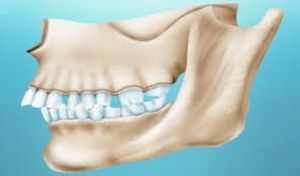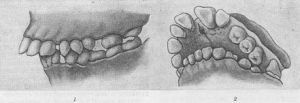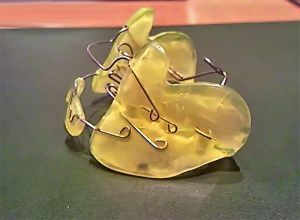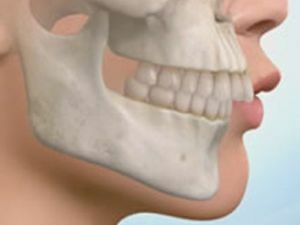 There is a whole complex of pathologies in which a person has an incorrect bite due to the fact that the upper and lower rows of teeth do not close in the anteroposterior plane.
There is a whole complex of pathologies in which a person has an incorrect bite due to the fact that the upper and lower rows of teeth do not close in the anteroposterior plane.
The condition when the upper part protrudes forward is called prognathia( in another terminology, the prognathic or distal bite).And in the event that the lower half of the jaw lies ahead, the doctor diagnoses prognosis.
These anomalies can be combined with each other, which causes their symptoms to overlap.
Contents of
- Causes of development
- Classification and features
- Diagnostic criteria
- Defect correction
- Possible consequences
Causes of development of
Prognathia develops for many reasons that usually occur in infancy and early childhood. These provoking factors include:
- violation of the function of normal breathing through the nose due to its permanent stuffiness, as the jaw begins to stretch forward against the background of the cessation of its development in breadth;
- development of diseases of the jaw apparatus, especially during artificial feeding;
- the habit of sucking a finger, a lower lip, gnawing stationery, excessive addiction to the nipples facilitate the extension of the lower row of teeth;
- the jaw grows incorrectly if the child walks with the head down due to some posture disease;
- malocclusion of the teeth or their early removal due to tooth decay;
- suffered from rickets and other diseases that affect bone tissue.
Also, the disease can occur with certain disorders, inflammatory processes, insufficient intake of fluoride and calcium at the stage of development in the womb. Moreover, it is passed from parents to children.
Classification and features of
Prognathia is classified according to the position of the jaw into several varieties: 
- , the first form suggests insufficient development of the lower jaw against a background of normal upper growth;
- second is characterized by excessive formation of the upper jaw or upper row of teeth, while the lower one remains in its normal position;
- with the third form combines the symptoms of the two listed above;
- with the feature of the fourth is only an insignificant "squeezing" forward of the upper front teeth, usually units and twos.
Also pathology can acquire:
- true;
- is false;
- and dual forms.
The true shape of the anomaly is characterized by pronounced signs:
- The patient has a significantly higher middle facial front. This shortens the upper lip and there is a tension in the muscle tissues of the mouth.
- The upper dentition extends beyond the oral cavity, biting the lower lip. Thus the person can not completely close a mouth.
- Pathology is characterized by a change in the position of the upper teeth: the gap between the incisors is markedly expressed, there may be crowding of teeth or their divergence in a fan.
Diagnostic criteria
Diagnosis of anomalies in the development of the bones of the jaw is performed by external examination, as well as by examining the oral cavity with a dentist or orthodontist and by taking an X-ray.
On the formation of a violation will be indicative of:

In the photo, a pronounced exosanguination of the first type
- the forward upper jaw and its incorrect position at an angle relative to the base of the skull;
- pathologically round face;
- formation of deep chin creases;
- lack of opportunity to shut your mouth;
- protruding lower lip;
- fan-shaped placement of teeth.
Depending on the individual characteristics and the form of the disease, the prognathic bite has the following symptoms:
- the patient can not bite food because of the forward incisors;
- speech disorders occur;
- makes breathing difficult with the mouth;
- with an incorrect occlusion, the oral cavity is seriously reduced, which means that a person loses the ability to thoroughly chew food.
Defect correction

Apparatus Frenkel
With true prognathic correction of the patient's condition is accompanied by certain difficulties. In particular, when forming a patient with a permanent bite, its correction by orthopedic methods is no longer possible. In this case, you can not do without an operation.
Therefore, it is highly desirable in time to detect the child's initial symptoms of pathology and wean him from the bad habits accompanying the disease. For this, the orthopedic doctor corrects the bite of the milk teeth with the help of orthodontic devices.
Actively applied:
- instruments-activators, stimulating the growth of the lower and obstructing the development of the upper jaw;
- squeezing bandages that stop bone growth;
- use Frenkel's apparatus, which gives the jaw an anatomically correct appearance.
- sanitation of the mouth and nasopharynx.
During this therapy, parents ensure that the child does not put his fingers or any foreign objects into his mouth.
The method of surgical correction of the occlusion involves cutting the tissues and directing the jaw to the side at the required angle so that the upper and lower rows of the patient's teeth converge with each other.
The bones are then sealed in the correct position and fused for 1.5-2.5 months. Then the rehabilitation period passes, after which the patient in most cases restored a normal bite and he acquires the appearance of an absolutely healthy person.
Possible consequences of
If the prognosis of the upper jaw is not removed even at school age( up to 14-15 years), the adult person may face a mass of complications: 
- first of all, the external face defect causes the patient a serious psychological trauma, which leads to the formation of an inferiority complex, problems in his personal life;
- , secondly, chewing functions are violated, which can affect the state of the digestive system;
- another manifestation of the pathology unbaked in childhood are deviations in the area of speech, most often this is a lisp;
- with an incorrect position of the teeth develops caries faster, and any careless movement can cause a pain syndrome.
Thus, the prognathic bite is a rather serious maxillofacial pathology requiring timely treatment by an orthodontist.
